It's Time For a New Model of Human Evolution
https://www.discovermagazine.com/planet-earth/its-time-for-a-new-model-of-human-evolution
New evidence suggests we need to rethink our current models of how humans evolved.
By Gemma Tarlach Apr 1, 2018 8:00 PM
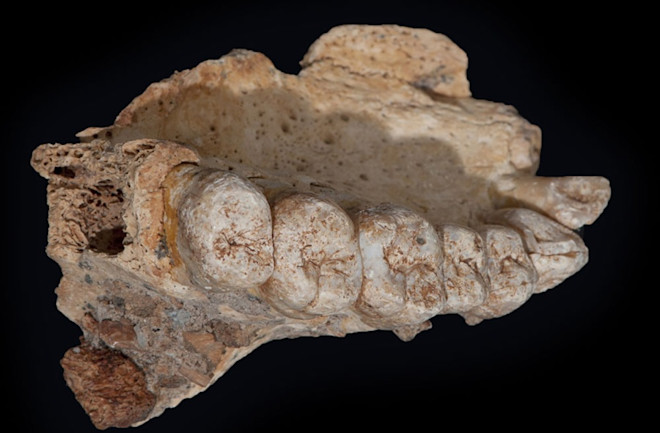
A partial jawbone from an anatomically modern human, found in Israel, is more than 170,000 years old. Israel Hershkovitz/Tel Aviv University
How well do we know ourselves? The fossil record of hominins, our ancestors and closest kin, is limited, and the exploration of our collective deep history through genetic analysis is still a relatively new field. Neither excavations nor lab work has been able to reconstruct, definitively, the earliest chapter of the Homo sapiensstory.
For decades, two competing models of human evolution have dominated the field. One claims that H. sapiensevolved in a single place, Africa, and left that continent only fairly recently; the other suggests that our species evolved in multiple regions across both Africa and Eurasia.
While debate between proponents of the two models rages on, there’s one big problem: Researchers keep finding fossil and genomic evidence that don’t fit either model.
A paleoanthropological review published in Science in December acknowledged that the evidence had reached a tipping point. It’s time, the authors said, for a new model of how our species evolved and spread across the world. But how does this new model compare with its predecessors?
Recent Africa Origin Model
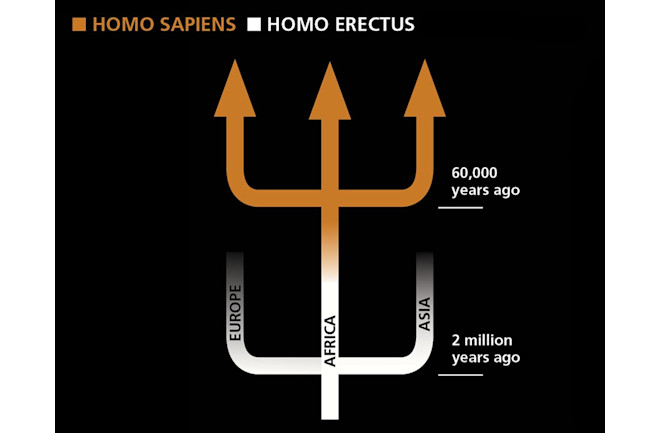
Dan Bishop/Discover
Beginning in the mid-20th century, fossils unearthed in Africa showed a progression, over millions of years, from a primitive bipedal primate to anatomically modern humans. Based on those fossils, researchers developed the Recent Africa Origin (RAO) model for human evolution and migration. According to the RAO model, although some groups of our predecessor Homo erectus left Africa roughly 2 million years ago, those early explorers eventually died out and did not contribute significantly to modern human ancestry. Instead, H. sapiens evolved exclusively in Africa and left the continent only about 60,000 years ago to spread across Eurasia. The RAO model has dominated Western thinking about human evolution for decades.
Multiregionalism Model
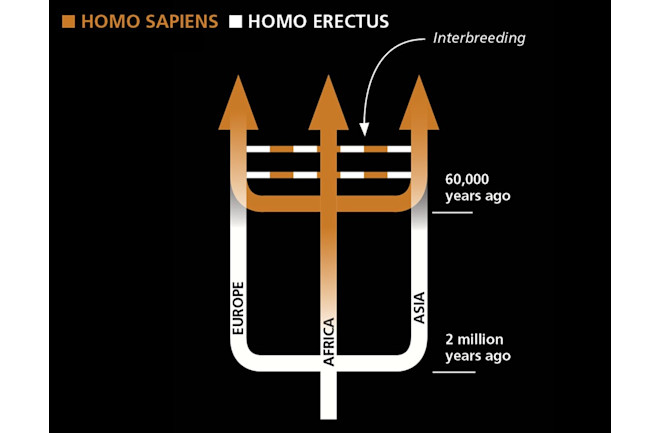
Dan Bishop/Discover
The RAO model does not account for some hominin fossils found outside of Africa, especially in China, that are 100,000 years or older but appear to belong to anatomically modern humans. Based on these fossils and some artifacts, a challenge to RAO emerged: multiregionalism. According to this model, after H. erectus populations left Africa roughly 2 million years ago, these intrepid hominins settled in pockets across Eurasia, where they continued to evolve into regional populations of H. sapiens. Multiregionalism agrees with one aspect of RAO: When the relative latecomer sapiens left Africa 60,000 years ago and met up with other hominin populations in Eurasia, some interbreeding occurred. According to multiregionalists, however, the ancestry of human populations outside of Africa, particularly in Asia, is rooted in the earlier regional H. erectus populations.
New Model
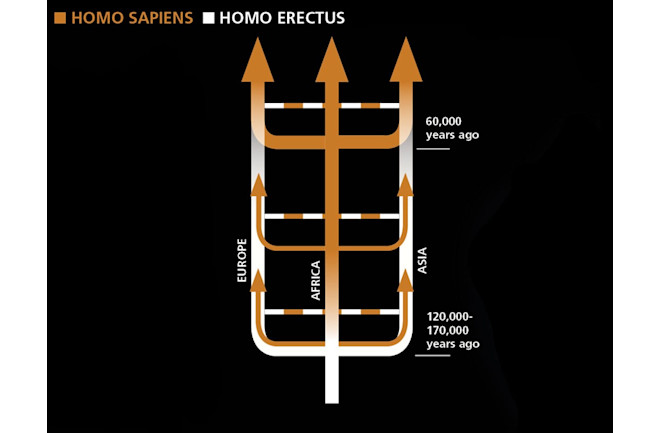
Dan Bishop/Discover
According to the new model proposed in the December review in Science, H. sapiens evolved in Africa but left the continent much earlier, about 120,000 years ago, and in multiple waves of migration. In January, the work of a separate team, also published in Science, pushed the start date for modern humans migrating out of Africa even farther back: Anatomically modern human fossils found in Israel were dated to more than 170,000 years old. While some of the early pioneers perished, others survived, reaching as far as Australia and East Asia. There, and along the way, migrating H. sapiens met and sometimes interbred with other hominins, including Neanderthals in Europe and Denisovans in Asia, as well as, potentially, other populations not yet known to science. The new and more complex model doesn’t just reflect the latest research — it also emphasizes the interconnectedness of our entire species and our closest kin.
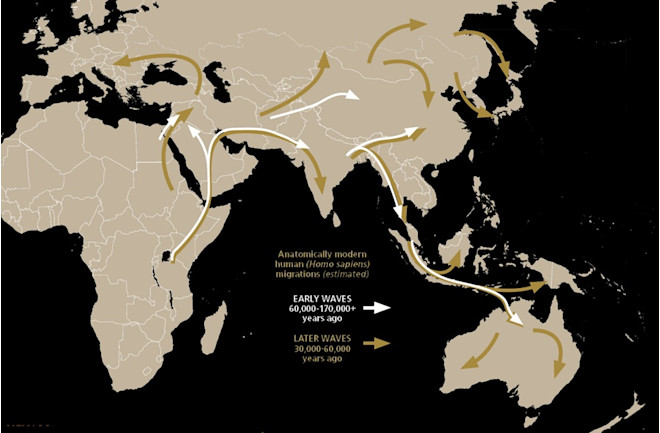
Dan Bishop/Discover and Ekler/Shutterstock
我们对自己了解多少? 我们的祖先和最亲近的人科动物的化石记录是有限的,通过基因分析探索我们集体的深层历史仍然是一个相对较新的领域。 无论是挖掘工作还是实验室工作都无法明确地重建智人故事的最早篇章。
几十年来,两种相互竞争的人类进化模型一直主导着该领域。 有人声称智人在一个地方进化,即非洲,并且最近才离开该大陆; 另一个表明我们的物种在非洲和欧亚大陆的多个地区进化。
虽然这两种模型的支持者之间的争论仍在继续,但存在一个大问题:研究人员不断发现不适合任何一种模型的化石和基因组证据。
去年 12 月发表在《科学》杂志上的古人类学评论承认,证据已经达到临界点。 作者说,现在是时候建立一个新模型来说明我们的物种如何在世界范围内进化和传播。 但是这个新模型与其前辈相比如何呢?
最近的非洲血统模特 Dan Bishop/Discover
从 20 世纪中叶开始,在非洲出土的化石显示了经过数百万年的进化,从原始的双足灵长类动物到解剖学上的现代人类。 基于这些化石,研究人员开发了人类进化和迁移的近代非洲起源 (RAO) 模型。 根据 RAO 模型,虽然我们的前身直立人的一些群体在大约 200 万年前离开了非洲,但这些早期探险者最终灭绝了,并且对现代人类祖先没有做出重大贡献。 相反,智人只在非洲进化,仅在大约 60,000 年前离开非洲大陆,传播到欧亚大陆。 几十年来,RAO 模型一直主导着西方对人类进化的思考。
多区域主义模型 Dan Bishop/Discover
RAO 模型没有考虑在非洲以外发现的一些人科动物化石,尤其是在中国,这些化石已有 10 万年或更早,但在解剖学上似乎属于现代人类。 基于这些化石和一些人工制品,对 RAO 的挑战出现了:多区域主义。 根据这个模型,大约 200 万年前直立人种群离开非洲后,这些勇敢的古人类在欧亚大陆各地定居,并在那里继续演变成区域性智人种群。 多区域论同意 RAO 的一个方面:当相对较晚的智人在 6 万年前离开非洲并与欧亚大陆的其他人类种群相遇时,发生了一些杂交。 然而,根据多区域主义者的说法,非洲以外的人群,尤其是亚洲人群的祖先,植根于早期的区域性直立人种群。
新模特 Dan Bishop/Discover
根据 12 月发表在《科学》杂志上的评论提出的新模型,智人在非洲进化,但离开非洲大陆的时间要早得多,大约在 12 万年前,并经历了多次迁徙浪潮。 今年 1 月,同样发表在《科学》杂志上的另一个团队的工作将现代人类迁出非洲的开始日期推得更早:在以色列发现的解剖学上的现代人类化石可追溯到 17 万多年前。 虽然一些早期的先驱者死了,但其他人幸存下来,最远到达澳大利亚和东亚。 在那里,一路上,迁徙的智人遇到了其他人科动物,有时还与其他人科动物杂交,包括欧洲的尼安德特人和亚洲的杰尼索瓦人,以及可能还不为科学所知的其他种群。 新的和更复杂的模型不仅反映了最新的研究——它还强调了我们整个物种和我们最亲近的亲属之间的相互联系。
迁移地图